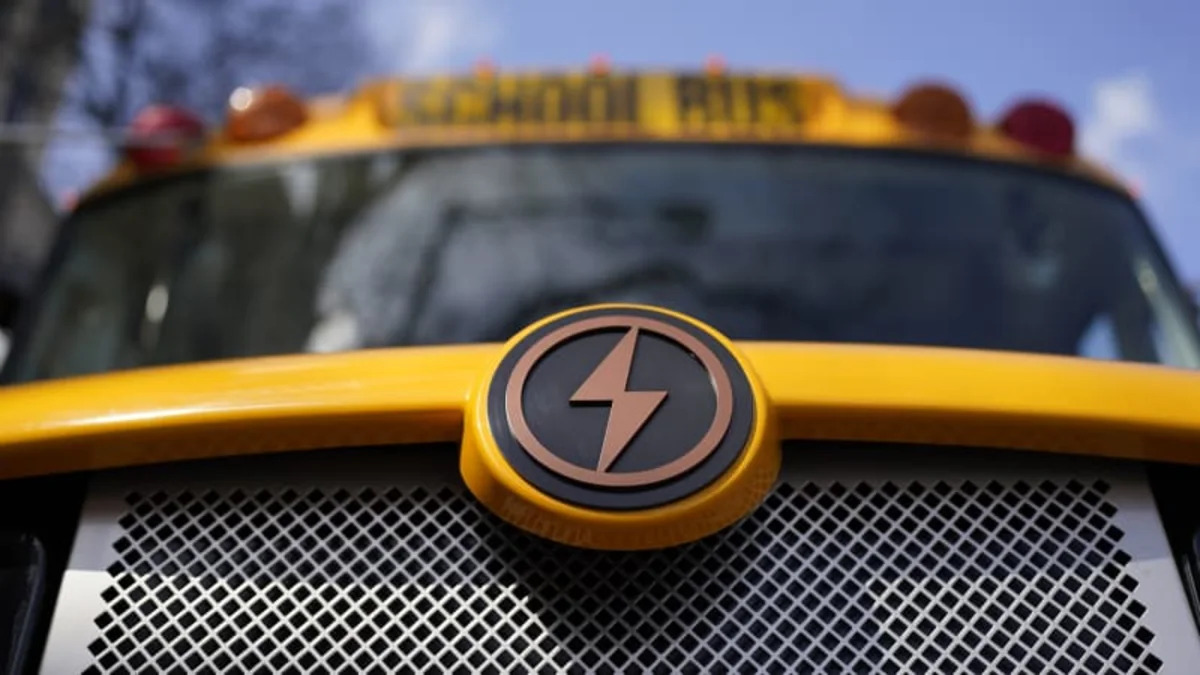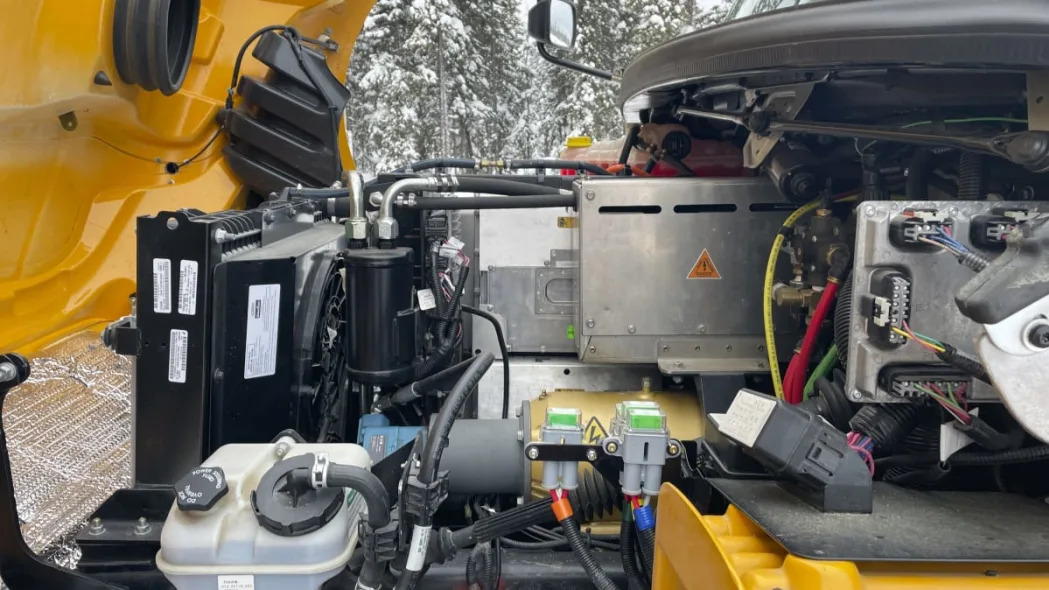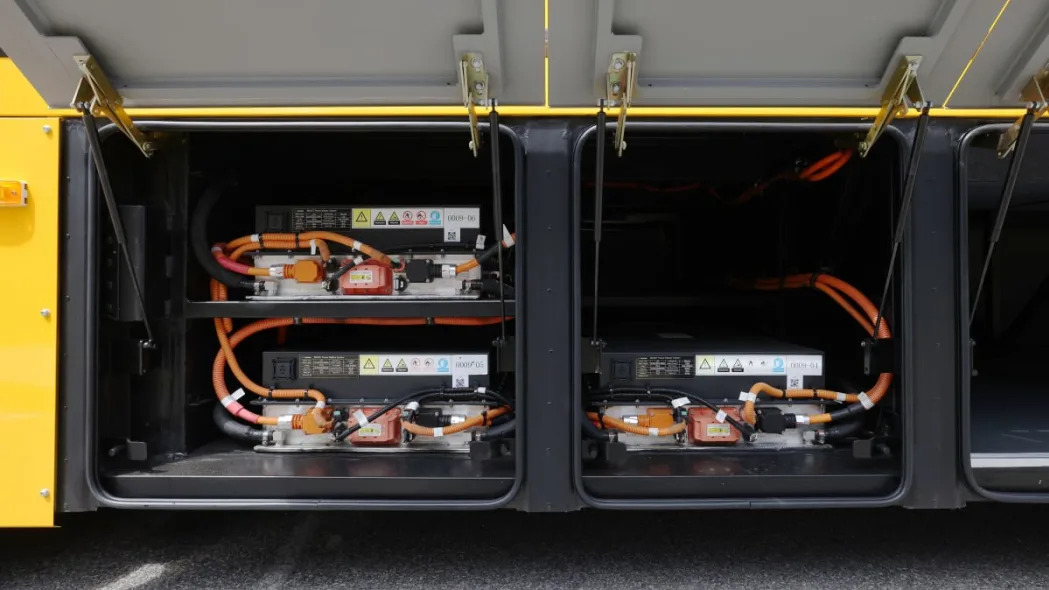The American school bus of the future won’t differ too much from its current iconic design: The wheels will still go round and round, the horn will go honk, honk, honk, and the wipers will swish, swish, swish. But if the transition from fossil fuels continues to accelerate, the engine won’t go vroom, vroom, vroom. It won’t make much noise at all, because it will be electric.
Most school buses today run on diesel. The climate footprint of a diesel school bus is about 3.3 pounds of carbon dioxide equivalent (CO2e) per mile, more than double the per-mile footprint (roughly 1.5 pounds of CO2e) for a bus powered on the average U.S. electric grid, according to Argonne National Laboratory. If a large share of the American school bus fleet — the largest mass transportation system in the country — electrifies, that would translate to a significant emissions cut.
What’s more, diesel exhaust is carcinogenic. And specific components of the tailpipe fumes, such as particulate matter and nitrogen oxides (NOx), are linked to asthma and other respiratory problems in children.
“This is really a health issue,” says Almeta Cooper, national manager for health equity with the environmental group Moms Clean Air Force. But with almost a half-million school buses on the road daily, “it’s so much part of the scenery, people don’t even realize,” she says. That’s why Cooper and other parent activists have spent recent years rallying behind the electric bus. Now, she says, the technology is finally starting to gain traction.
In 2016 there were only 10 electric school buses “committed” — meaning they’d been awarded, ordered or delivered, or were in operation — across the U.S., according to the global research nonprofit World Resources Institute (WRI). By December 2022, that number had jumped to 5,612. (That tally doesn’t include a partnership between bus dealer Midwest Transit Equipment Inc. and electric power system maker SEA Electric LLC to retrofit 10,000 diesel buses into electric; so far, only 22 of these buses have been ordered.) Those numbers account for the Environmental Protection Agency awarding more than $900 million in funding for nondiesel vehicles, mainly electric ones, through its new Clean School Bus Program. Even more federal support for school bus electrification is coming online this year, thanks to the 2021 Bipartisan Infrastructure Law and the 2022 Inflation Reduction Act.
Why school buses are going electric
It helps that school buses are almost perfect for electrification. The summer break means buses are generally not pulling power from the grid during the hottest months of the year, when electricity demand can peak. In fact, bus batteries could potentially be a resource to send electricity back to the grid.
The range of a fully charged electric bus is upwards of 100 miles, covering most routes. There’s also a natural window to charge during the day while kids are in class.
Take, for example, Montgomery County Public Schools (MCPS), a large suburban district in Maryland that currently operates 86 electric buses. On a typical day, an electric bus picks up students and drops them off at one high school, one middle school and two elementary schools from 7 a.m. to 9:30 a.m.
Occasionally, the buses take trips during the school day to nearby destinations. Although longer field trips pose a problem for range, a hypothetical 13-mile round trip to the Smithsonian National Zoo in Washington shouldn’t drain the battery. But if a bus needs to recharge during the day, it usually only recharges up to whatever it needs to finish the day’s routes.
“What you’ve got at the moment is many, many districts and users are putting their toes in the water,” says Kevin Bangston, CEO of Thomas Built Buses.
Not so for Montgomery County Public Schools, which plans to operate another 240 electric buses by the end of 2024 on top of the 86 already on the road. “We’re the sixth-largest school bus fleet in the U.S.,” says Gregory Salois, director of district transportation. “If you are able to do this successfully, it would be quite the advertisement for others to do it.”
Then, from 2 p.m. to 4:30 p.m. the bus picks up students from the schools and drops them off at home. Typically, morning and afternoon routes can be completed on a single charge. In colder months, the bus has less mileage per charge because heating the bus saps energy. Consistent high-speed driving can also deplete a battery more quickly.
At the end of the day, the bus returns to the bus depot to fully recharge overnight. Recharging to 100% takes about four hours, depending on how much charge is left.
For now, though, electric buses still make up less than 1% of the school buses on U.S. roads. If this were a board game, they’d be stuck at “go.” But increased demand and funding, technological innovation and a streamlined supply chain promise to bring change, says Katherine Roboff, a senior manager for communications and engagement with WRI’s Electric School Bus Initiative. “We’ll be off of ‘go’ pretty soon,” she says. “There’s definitely good progress happening.”
Most school districts ordering electric buses today are starting small, with purchases of one, two or a handful of buses. “What you’ve got at the moment is many, many districts and users are putting their toes in the water,” says Kevin Bangston, president and chief executive officer of the school bus maker Thomas Built Buses Inc. in High Point, North Carolina. “They are running a couple of buses, so they need a charger or two.”
Not so for Montgomery County Public Schools, which plans to operate another 240 electric buses by the end of 2024 on top of the 86 already on the road. “We’re the sixth-largest school bus fleet in the U.S.,” says Gregory Salois, director of the district’s department of transportation. “If you are able to do this successfully, it would be quite the advertisement for others to do it.”
The more electric buses a district has, the more complicated it is to deploy them, because of the additional infrastructure and support needed. The Maryland school district partners with Highland Electric Fleets, a startup backed by large investors that purchases the buses, oversees charging and related infrastructure and pays all the utility costs.
According to Salois, who started his job after the electrification process began, Highland proposed a package that “would basically be budget neutral for Montgomery County.” The county is paying Highland the equivalent of a diesel bus for each electric one. At the time, a diesel bus cost $160,000. An electric bus cost $420,000, with an additional $45,000 to $50,000 for supporting infrastructure. (Although prices have since come down and are projected to keep dropping, they will still be much higher than diesel for years.)
Only a few miles from Montgomery County, another large district, Virginia’s Fairfax County Public Schools, is following a different model, getting support from the local utility Dominion Energy Inc. to help pay for buses and install and maintain charging infrastructure.
Another way to reduce the cost burden of electrification is with a “repower” bus, a fossil fuel bus that’s retrofitted to be electric and costs a fraction of a new electric bus. A repower bus “can be as low as $100,000 or as high as $175,000,” says Michael Backman, vice president for sales and marketing for the repower business Unique Electric Solutions Inc. in Holbrook, New York. A downside of retrofitted buses: They may not have the same lifespan as new ones.
Federal funding revs up a bumpy transition
There’s more financial support now for school districts to make the switch. It began with California, New York and other states offering incentives to help them shoulder the cost of transitioning to cleaner buses, including propane, natural gas and electric models. Now the federal government is stepping up, too. As part of the Diesel Emissions Reduction Act program and the American Rescue Plan, the EPA funded the replacement of 53 diesel buses with electric ones between 2019 and 2021.
But the passage of the Bipartisan Infrastructure Law in 2021 changed everything. With the law’s funding, the EPA introduced the Clean School Bus Program. It has a $5 billion budget through fiscal year 2026, making it the largest pot of money for low- and zero-emission buses. When the agency’s first round of funding opened last spring, the response from district officials was overwhelming, says EPA Transportation and Climate Division Director Karl Simon. “We got $4 billion worth of applications when we rolled out the rebates last year, for a $500 million offering,” he says. So far the EPA has given out more than $900 million, almost double the proposed amount. Most of that money went toward electric buses, as opposed to propane or gas ones.
The EPA plans to offer roughly $1 billion every year until the money runs out, Simon says. Moreover, the Inflation Reduction Act offers additional millions through various programs that may be used to fund school bus electrification.
Although Montgomery County entered into its Highland contract before the EPA’s program even started, officials there have seen the impact it’s had on demand. Salois says the county has gotten calls from school officials in Florida, Kentucky and West Virginia asking for advice on how to go electric. He’s an electric bus advocate, but he’s also honest with anyone who asks, saying the transition is and will continue to be bumpy.
In an ideal world, the driver of an electric school bus does three routes in the morning for elementary, middle school and high school students, takes a midday break to charge, and then completes the afternoon routes before returning the bus to the depot to charge overnight. But in Montgomery County, almost two-thirds of the buses have duties in the middle of the day, such as field trips or shuttling kids between schools to attend special programs, Salois says. “Usually we cannot put an electric bus on a midday schedule,” he says, adding that he expects this to change in the future as the range of electric buses increases.
Streamlining coordination with utilities and finding more money to help pay for the infrastructure that goes along with the buses are crucial to expanding the nation’s electric school bus fleet, says Sue Gander, director of WRI’s Electric School Bus Initiative. So, too, will be some technological innovation when it comes to accelerating charging speed and expanding bus range.
In another clear sign that electric buses are here to stay, all three of the largest US school bus makers — Blue Bird Corp., Thomas Built Buses and Navistar International Corp.’s IC Bus — started producing electric models in recent years. All three companies say that demand for their electric buses is only growing and that they’ve increased their staff devoted to this side of the business. But though Blue Bird expects sales of electric buses to grow to more than 40% of the school bus business in the long term, Navistar’s IC says its modeling indicates electric buses will be the “primary choice of the industry by 2029.”
Bangston of Thomas Built Buses sees the future as electric, full stop. “The clear winner is an absolute zero-emissions vehicle,” he says. “This industry is going electric, in my mind.”




Sign in to post
Please sign in to leave a comment.
Continue